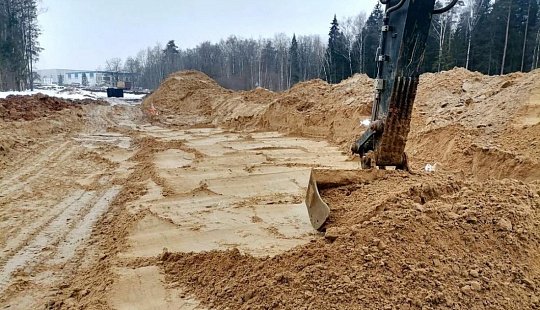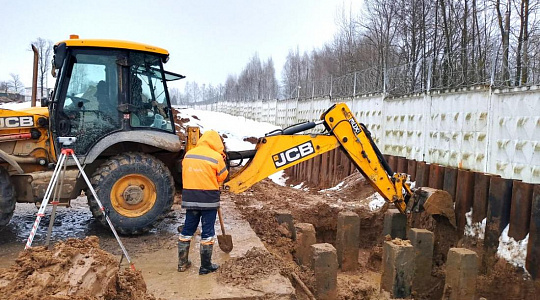28.03.2024
To ensure convenient traffic flow exit from the future highway, the project provides for the expansion of the 2.7-kilometer section of Afanasovsky Highway from 2 to 4-6 lanes. Additionally, sidewalks and public stops will be improved, and the intersection of vehicular and pedestrian traffic will be eliminated. To achieve this, three overpasses are being built in the areas of the densest pedestrian traffic. The loading of piles under the pavilions of pedestrian crossings 1 and 2 has been completed, concrete has been laid on three grillages of the first crossing, and reinforcement of the others continues around Dmitrovskoe Highway. The builders began installing rainwater drainage and water discharge from local treatment facilities. The work on rebuilding utility networks has been 35% completed, and the total volume of excavation work has exceeded 4,000 m3.
As a result of project implementation, unhindered high-speed car exit from the Mytishchi Expressway will be ensured both in the direction of Sheremetyevo International Airport and in the direction of the Northern Administrative District of Moscow. By increasing the number of traffic lanes in each direction, the capacity of this section of Afanasovskoye Highway will increase significantly.
The creation of the Mytishchi Expressway is a concession project implemented by VIS Group and the Government of the Moscow Region. This is a modern 16-kilometer highway that will act as a backup for the MKAD section, and will also connect three highways and more than a dozen settlements. Transport accessibility for almost a million residents of the Moscow region will increase, travel time to Moscow and back will be reduced by an average of one hour. Traffic along the highway will be continuous; for this purpose, barrier-type toll booths have been redesigned to install a free-flow system.
VIS Group begins roadbed reconstruction at Afanasovskoe Highway exits in Moscow
VIS Group is reconstructing a section of Afanasovskoye Highway, which will connect Dmitrovskoye Highway with the Mytishchi Expressway being built by the holding. The work is being carried out by the Group’s construction division under a government contract. To date, roadbed construction has begun on two of the three exits of the main route of the existing road. All work is carried out without vehicle traffic restrictions.To ensure convenient traffic flow exit from the future highway, the project provides for the expansion of the 2.7-kilometer section of Afanasovsky Highway from 2 to 4-6 lanes. Additionally, sidewalks and public stops will be improved, and the intersection of vehicular and pedestrian traffic will be eliminated. To achieve this, three overpasses are being built in the areas of the densest pedestrian traffic. The loading of piles under the pavilions of pedestrian crossings 1 and 2 has been completed, concrete has been laid on three grillages of the first crossing, and reinforcement of the others continues around Dmitrovskoe Highway. The builders began installing rainwater drainage and water discharge from local treatment facilities. The work on rebuilding utility networks has been 35% completed, and the total volume of excavation work has exceeded 4,000 m3.
As a result of project implementation, unhindered high-speed car exit from the Mytishchi Expressway will be ensured both in the direction of Sheremetyevo International Airport and in the direction of the Northern Administrative District of Moscow. By increasing the number of traffic lanes in each direction, the capacity of this section of Afanasovskoye Highway will increase significantly.
The creation of the Mytishchi Expressway is a concession project implemented by VIS Group and the Government of the Moscow Region. This is a modern 16-kilometer highway that will act as a backup for the MKAD section, and will also connect three highways and more than a dozen settlements. Transport accessibility for almost a million residents of the Moscow region will increase, travel time to Moscow and back will be reduced by an average of one hour. Traffic along the highway will be continuous; for this purpose, barrier-type toll booths have been redesigned to install a free-flow system.





